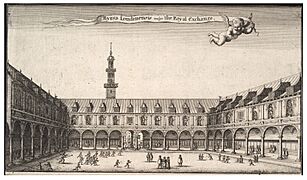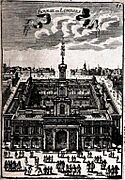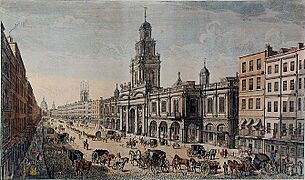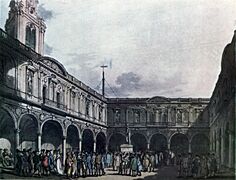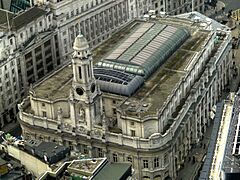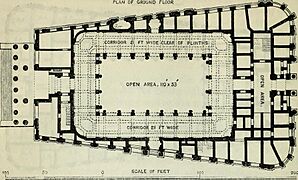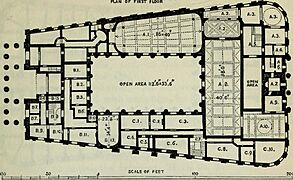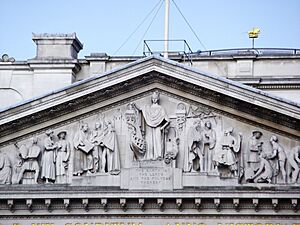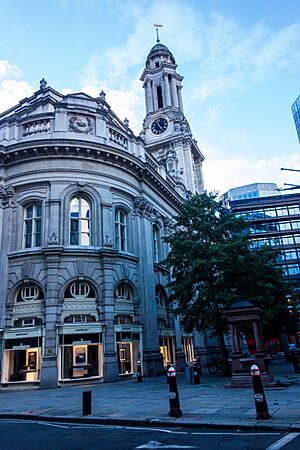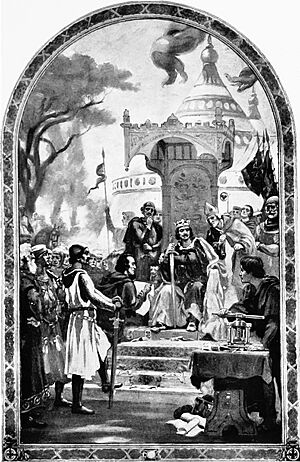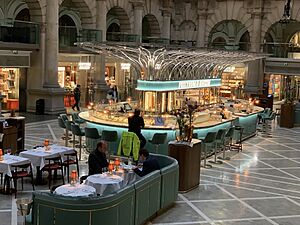Royal Exchange, London facts for kids
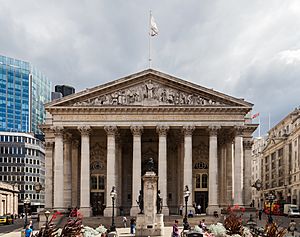
The west façade of the Royal Exchange from the Bank junction
|
|
| Location | London, United Kingdom |
|---|---|
| Coordinates | 51°30′49″N 0°05′14″W / 51.51361°N 0.08722°W |
| Opening date | 23 January 1571 (original structure) 28 October 1844 (current structure) |
| Owner | The Ardent Companies (since 2022) |
| Architect | Sir William Tite |
| No. of stores and services | 33 stores; 5 restaurants and cafes |
| Parking | None |
| Public transit access | |
The Royal Exchange in London is a famous building with a long history. It was first built in the 1500s by a merchant named Sir Thomas Gresham. He wanted a special place for people to buy and sell things in the City of London.
The land for the building was given by the City of London Corporation and the Worshipful Company of Mercers. They still own it together today. When the first building opened, Queen Elizabeth I visited and gave it the special name "royal."
The Royal Exchange has been destroyed by fire twice and rebuilt. The building you see today was designed by Sir William Tite in the 1840s. It has a unique shape and is located in the heart of London, near Cornhill and Threadneedle Street.
For nearly 150 years, the building was home to Lloyd's of London, a famous insurance market. Today, the Royal Exchange is a place with fancy shops and restaurants.
The steps of the Royal Exchange are also a traditional spot for important announcements. For example, when a new king or queen takes the throne, a special messenger reads the news to the public right there.
Contents
A Look at the Royal Exchange's Past
The idea for the Royal Exchange came from Richard Clough in 1562. He was inspired by a building in Antwerp, Belgium, which was the world's first special market for trading. Thomas Gresham, who worked for the English crown in Antwerp, knew this building well.
The Royal Exchange was Britain's first building made just for business. Richard Clough even brought some building materials like stone and glass all the way from Antwerp.
Queen Elizabeth I officially opened the Royal Exchange on January 23, 1571. She gave it its "royal" name and allowed it to sell drinks and valuable items. For a long time, only goods were traded there. Stockbrokers, who buy and sell shares, were not allowed inside because they were considered too noisy! They had to do their business in nearby coffee houses.
Sadly, Gresham's first building was destroyed in the Great Fire of London in 1666.
The writer Voltaire once said about the Royal Exchange: "It's a place where people from all nations meet for everyone's benefit. People of different religions do business together as if they were all the same."
A second building was built on the same spot, designed by Edward Jarman. It opened in 1669. This building also burned down on January 10, 1838, due to an overheated stove. The fire was so big it could be seen from 24 miles away! After this fire, the Lloyd's insurance market had to move out temporarily.
-
The first Royal Exchange, drawn by Wenceslaus Hollar
The Building You See Today
The third Royal Exchange building, which is still standing, was designed by Sir William Tite. It has the same basic shape as the earlier buildings: a four-sided structure around a central courtyard. This courtyard was where merchants used to meet and do business.
The inside parts of the building, designed by Edward I'Anson in 1837, used concrete. This was quite new for building at that time! The building also has cool sculptures by Richard Westmacott (the younger) and metalwork by Henry Grissell.
Queen Victoria officially opened the current building on October 28, 1844. Business started there on January 1, 1845.
Did you know that Paul Julius Reuter started his famous news agency, Reuters, near the Royal Exchange in 1851? It later moved to another street.
Front Entrance and Sculptures
The front of the building has a grand entrance with eight tall columns. Above these columns is a triangular section with sculptures by Richard Westmacott (the younger). These sculptures show seventeen figures, including London merchants and traders from other countries. The main figure in the middle represents "Commerce" (business).
There's also a Latin message carved on the building that means: "Founded in the thirteenth year of Queen Elizabeth, and restored in the eighth of Queen Victoria."
Important Statues
Inside the central courtyard, you'll find two statues in special alcoves. One is of King Charles II, and the other is of Elizabeth I. The Charles II statue actually survived the big fire of 1838! The Elizabeth I statue was made because she was the queen who gave the building its "Royal" title.
In front of the main entrance, there's a large statue of Arthur Wellesley, 1st Duke of Wellington, a famous military leader. The bronze for this statue came from French cannons captured during wars! It was revealed on June 18, 1844, on the anniversary of the Battle of Waterloo.
Between the Wellington statue and the building steps, you'll see the London Troops Memorial. This monument remembers soldiers from London who died in the First World War. It has two bronze statues of soldiers and a lion on top.
The Golden Grasshopper
Look up at the clock tower on the Royal Exchange, and you'll see a golden Grasshopper. This grasshopper is a weathervane, showing which way the wind is blowing. It was the special symbol of the founder, Sir Thomas Gresham.
Legend says that a grasshopper's chirps once helped someone find a lost baby, who later became the first person in the Gresham family. This golden grasshopper weathervane is 11 feet long and survived the 1838 fire! It sits 177 feet above the street on a clock tower with a clock made by Edward John Dent.
The Bells of the Tower
The tower of the Royal Exchange has 15 bells, all made in 1844. They can play different tunes, including "God Save the King" and "Rule Britannia!". The largest bell is also the hour bell.
Amazing Murals
Starting in 1892, artists painted 24 scenes from London's history on the walls of the first floor. These include famous artists like Sir Frederic Leighton and Sir Frank Brangwyn. The paintings show important moments like:
- Phoenicians trading with the early Britons on the coast of Cornwall
- Alfred the Great repairing the walls of the City of London
- William the Conqueror granting a Charter to the Citizens of London
- King John sealing Magna Carta
- The Opening the first Royal Exchange by Queen Elizabeth I
- The Great Fire of London, 1666
- Founding of the Bank of England, 27 July 1694
- Destruction of the Second Royal Exchange in 1838
- Opening of the Royal Exchange by Her Majesty Queen Victoria, 28 October 1844
- Women's Work in the Great War, 1914–1918
- Modern Commerce
During World War II, business at the Royal Exchange almost stopped. Luckily, the building survived the bombings, even with some close calls.
The Royal Exchange Today
By 1982, the Royal Exchange was in need of repair. The glass roof was even in danger of falling apart! A new financial market, LIFFE, became the main tenant. They used the courtyard as their trading floor.
In 2001, the Royal Exchange was completely updated inside. This included fixing the building and replacing the roof over the courtyard.
In a small lane near the eastern entrance, you can find two more statues. One is of Paul Julius Reuter, who started Reuters news agency there. The other is of George Peabody, who founded a charity and a business that later became J.P. Morgan & Co..
In recent years, the ownership of the Royal Exchange has changed. In 2013, a Canadian company bought the lease. Then, in 2022, another company called Ardent UK bought the retail part of the building.
See also
 In Spanish: Royal Exchange para niños
In Spanish: Royal Exchange para niños


